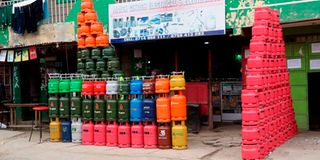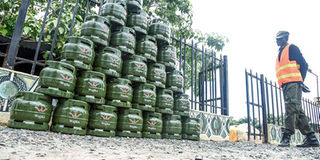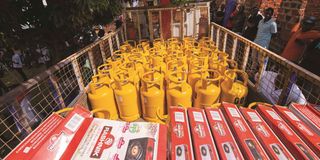
Retailers selling liquefied petroleum gas (LPG).
Multinational oil marketing companies (OMCs) have lined their pockets with billions in profits from the sale of tax-free cooking gas even as consumers pay higher prices for the liquefied petroleum gas (LPG), contradicting the government’s pro-poor policy intentions.
Documents seen by the Nation reveal how some of the OMCs have been smiling all the way to the bank by paying Sh1,261 to refill a 13-kilogramme LPG cylinder at the Mombasa Terminal while charging consumers upwards of Sh3,200, representing a profit margin that is two and half more than the wholesale rate, or a markup of 156 per cent.
This has left consumers paying a higher retail price for 13kg of cooking gas compared to June last year before the government scrapped the eight per cent value added tax (VAT), two per cent railway development levy and 3.5 per cent import declaration fees, aimed at shifting households to the less dirty cooking fuel. Besides the removal of taxes, OMCs have also benefitted from lower global prices of LPGs and a stronger shilling, factors that have in the past been a perfect bogeyman for multinationals charging higher retail prices.
With these cost factors declining, the gate prices for dealers at the Mombasa Terminal have dropped by at least a third in the past year. Yet, these benefits, in the form of lower wholesale costs to OMCs, have not been passed on to consumers, with some government officials mulling the introduction of price control similar to the one applied to the three petroleum products. Economists have, however, been opposed to this path. Instead, they have been pushing for the restructure of the industry to make it more competitive by allowing more independent players rather than the current environment where the upstream market is dominated by a few players.
Rates
Rubis Kenya, for example, bought a tonne of LPG at the Mombasa Terminal at a wholesale rate of $775 (Sh99,975) on March 13, working to around Sh1,300 per 13kg. However, the French dealer has been selling the same cooking gas to consumers at Sh3,140, with an enviable profit margin of 156 per cent.
Rubis Kenya had promised to come back to us with answers on why they had not brought down the retail prices in line with the scrapping of taxes, lower global prices and stronger shilling, but had not reached out by press time.
TotalEnergies and Vivo Africa (Afrigas) that also refilled their LPGs at the Mombasa Terminal at around the same price are retailing 13kg cooking gas at Sh3,190.
International LPG prices have continued to decline, with the Mombasa Terminal similarly reducing its wholesale rates, with May prices dropping by a further Sh2 per kilogramme. Observers note that the further drop in the landing prices in May should have resulted in the 13kg cylinder being Sh26 cheaper. However, OMCs continue to charge Sh3,190 to refill a 13kg cylinder, even after they paid Sh1,261 to refill it from African Gas and Oil Company at the Mombasa Terminal.
Global trends
Meanwhile, consumers have not experienced any relief, either from global price trends or the VAT waiver. “Government efforts to reduce LPG costs—including removal of VAT and initiatives like the planned cylinder subsidy—are being undermined by the excessive retail pricing of multinational marketers,” said a source close to the matter and who refused to be identified for fear of reprisal.

LPG gas cylinders on sale at City Cabanas, Nairobi, on October 15, 2019. PHOTO | FILE | NATION MEDIA GROUP
The sticky retail prices of cooking gas in light of the drop in wholesale prices appears to follow the ‘rocket and feather effect,’ a term used to describe how prices go up fast but come down slowly—just like a rocket launches quickly and a feather falls slowly.
Last month, the landing price for butane—the colourless, odourless flammable gas that is mixed with propane to produce LPG for cooking and heating—dropped by close to a third from about Sh135 a kilogramme to Sh99 after the government scrapped the eight per cent value-added tax (VAT).
Expected drop
This means that retail prices for 13kg LPG should have dropped by around 26.7 per cent in this period. Instead, consumers have yet to enjoy lower cooking gas prices, more than a year after these taxes were scrapped.
If anything, a 13kg refill retailed at an average of Sh3,190 last month compared to Sh3,069 before the taxes were removed in June last year.
The prices have stayed high, despite the strengthening of the shilling and lower global prices of LPG, a situation that saw the government mull the introduction of a price control system like the one on refined petroleum.
Shift to clean energy
More LPG is being consumed, despite high retail prices, amid a push by the government for consumers to shift to clean cooking fuel even as it launched a Sh3.1 billion project to supply 6,000 boarding schools with cooking gas, widening the opportunity for OMCs to cash in even more.
Director General for the Energy and Petroleum Regulatory Authority Daniel Kiptoo had not responded to why the OMCs were charging higher retail prices, despite the lower landing costs, and what the regulator was doing to cushion consumers.
Compared to small traders, prices quoted by multinationals are significantly higher than the average of Sh2,500 and Sh1,350 for a 13kg and six-kilogramme cylinder charged by the small dealers respectively.
In an earlier interview, Mr Kiptoo had attributed the huge price variance to high overhead costs for dealers with vast markets.
“The disparity in the LPG retail price may be attributed to the difference in overhead costs between the multinationals and the small-to-medium-sized companies. Multinationals have a higher asset base, hence incur higher cylinder maintenance and distribution costs that are passed to customers,” he said.

A truck carrying LPG cylinders.
Cooking gas prices shot up three years ago by up to Sh350 following the reintroduction of the 16 per cent VAT, coupled with the global rally in prices of crude oil. LPG is extracted from crude oil. However, the dealers failed to lower the prices after the VAT was halved to eight per cent last year, denying customers the intended effect of the tax change.
Market forces
Players in the sector say that, unlike other petroleum products, LPG prices are determined by market forces. However, prices of fuel—petrol, diesel and kerosene—are controlled. “It is like the lubricants; prices don’t change a lot,” said one of the industry insiders.
Starting in the second half of last year, the shilling strengthened, even as global prices of LPG fell. But the retail prices of cooking gas remained higher than before the government gave the relief. Demand for LPG, however, remained high, with sales hitting all-time monthly records in July and August, a period when the government began distributing LPG cylinders to boarding schools.






